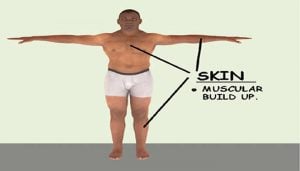Several weeks ago, we discussed at some length about what measures men need to take to boost their levels of testosterone using natural means and taking advantage of regular physical exercise and the abundance of certain types of food, vegetables and fruits in our environment.
However, this targeted essay that focused mainly on ways to enhance the level of testosterone in the body was largely ignored by many readers who rather wanted to know what medications they could take to boost their own level. Needless to say, not a single person who sent in a question has even conducted a test to determine what their circulating level of the hormone is. Testosterone is the primary sex hormone and anabolic steroid in males. In human beings, this hormone plays a key role in the development of the male reproductive organ such as the testes, penis and the prostate. This activity begins early within the first eight weeks of life as a fetus and continues after birth. Prior to that time, all foetuses look alike and resemble females. So it is reasonable to say that the increasing availability of testosterone is what makes the distinction between the genders.
So it is the elaboration of testosterone that creates the difference between males and females. Its activity within the developing male foetus is also speculated to be responsible for whether the testes descend properly into the scrotum or not. Beyond this period, testosterone again surges during the pubertal period and is responsible for the development of the secondary sexual characteristics that further define who a growing male is: the baritone voice, the growth of hair in the armpits, face and pubic area as well as the chest, arms and legs. There is also the further development of the body and bones such that the muscle mass increases and the bones become bigger and heavier. The hormone continues its functions into early adulthood and determines the sex drive seen in males, the libido. It is also responsible for the distribution of body fat and increases the strength of the muscles as well as increasing the red blood cell count and the number and quality of sperm cells. A small amount of this important hormone remains unused and is thus converted into a compound called oestradiol, a form of oestrogen which males also need for the completion of a number of activities around the body.
 Therefore, it is now clear that when males make a healthy amount of testosterone, they are regarded as healthy and fit. They are able to engage physically and reproduce. When the level is low, there are feelings of worthlessness and a loss of self-confidence. People lapse into sadness and depression while others will have trouble recalling events. There may be a certain level of lack of personal motivation and reduction in personal ambition. On the other hand, when the level of testosterone is abnormally high, the effects are sometimes quite surprising because the sperm count falls and could actually become abnormally low. There is shrinking of the testes and impotence could follow as a result. Furthermore, there occurs some damage to the heart’s muscle with an increased risk of sustaining a heart attack. Finally, the prostate becomes bigger. As it increases in size, the middle lobe of the organ squeezes the urethra and it becomes progressively difficult to pass urine. We discussed some of these uncomfortable changes when talking about benign prostatic hypertrophy and cancer of the prostate at various times in the past on this page.
Therefore, it is now clear that when males make a healthy amount of testosterone, they are regarded as healthy and fit. They are able to engage physically and reproduce. When the level is low, there are feelings of worthlessness and a loss of self-confidence. People lapse into sadness and depression while others will have trouble recalling events. There may be a certain level of lack of personal motivation and reduction in personal ambition. On the other hand, when the level of testosterone is abnormally high, the effects are sometimes quite surprising because the sperm count falls and could actually become abnormally low. There is shrinking of the testes and impotence could follow as a result. Furthermore, there occurs some damage to the heart’s muscle with an increased risk of sustaining a heart attack. Finally, the prostate becomes bigger. As it increases in size, the middle lobe of the organ squeezes the urethra and it becomes progressively difficult to pass urine. We discussed some of these uncomfortable changes when talking about benign prostatic hypertrophy and cancer of the prostate at various times in the past on this page.
We agreed in the last essay that exercises can boost the level of testosterone. This can increase the mass and bulk of our muscles in just a matter of weeks. In people who are in the body-building industry, there has long been the recognition that the increase in the levels of this hormone is responsible for the huge gains they make in their muscle bulk. Vitality also rises sharply during this period and it is clear that there is a direct relationship between both. Some types of exercises are better at raising testosterone levels than others but it needs to be emphasised that the more muscles you have, the higher your testosterone level is likely to be. In women, it is interesting to see that testosterone equally plays an important role in their physical well-being and their sexual health. Besides that, the rise in the levels of testosterone in the post menopausal woman is thought to be the reason why there is a rise in their stable haemoglobin concentration. It may also be responsible for the increased depth in the female voice with increasing age. In men, old age sees a fall in this hormone leading to increases in the size of the prostate gland and increased incidents of erectile dysfunction.
Research about this important hormone is therefore conclusive in its findings: it is important for both sexes to ensure they have healthy levels of testosterone even as they get older. And in doing the estimation of the level of this hormone, blood is taken from a vein early in the morning on the day of the test. That is so because the level is at its highest at that time of the day. As discussed in the previous essay, testosterone is produced in the testes of males and the ovaries of females. In both sexes, small amounts are produced in the adrenal glands which are responsible for producing the stress hormones as well. Testosterone reaches its peak at about the age of 20 years and slowly begins to decline. At this age the normal level of the hormone is between 300 and 1,000 nanograms per deciliter of blood (ng/dL) and it is considered to be low if it falls below 300. The effects of these figures on any man vary widely for, while some men can be ready for a second go at sex after as little as 10 minutes, the same average duration for a man to maintain an erection normally, others will need to wait for several hours or even days before they can attempt to do another one after having had an orgasm.
Testosterone is not the only contributing factor to suffering erectile dysfunction. While this is acknowledged as the most common sexual problem in men, it is important to bear in mind that its appearance in one’s life is not dependent on age. Some young men in their 20s are struggling with erectile dysfunction already while others in their 80s have absolutely no trouble maintaining an erection. It is, therefore, a problem that can appear at any age but health issues like high blood pressure, heart disease, obesity and diabetes are sometimes contributing factors to its presence in an individual. Many medications are promoted as being able to boost testosterone levels and the claims are often tempting. It is usual to warn patients that care must be taken in using such medicines. Most of the advertised ingredients do not boost muscle mass as claimed or increase testosterone levels. Worse, they carry significant adverse health risks when used. However, when there is a need to use it judiciously, it is available as a tablet, cream, patch, pellet or injection for both adult men and also children who occasionally demonstrate a need for its use.
Consequently, in those men who have isolated low testosterone, meaning that they do not have any other adverse health conditions such as the ones we mentioned above, it is possible to employ the use of this drug in any convenient form with the aim of righting what is perceived to be wrong. These vary from a rather small-sized penis in childhood to low sex drive in matured men. And the effects are often dramatic with increases in the size of the penis within a few weeks and the growth of pubic hair. In men, the symptoms of erectile dysfunction improve and sex drive also gets better. There is an associated elevation of the mood, improved energy status and an increase in the sperm count. A combination of all these factors can be of overall psychological benefit to the man who sees this inability as a serious impediment to happiness and social interaction.





